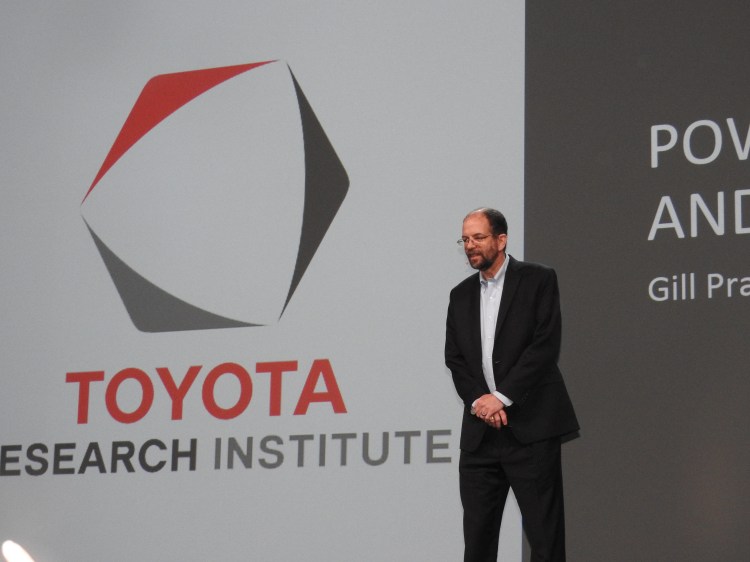Roughly 1.2 million people die per year in car accidents, and that is a problem that Toyota is trying to solve with self-driving cars and the artificial intelligence required to run them.
Toyota is very serious about this research, and Gill Pratt, CEO of Toyota Research Institute, announced today it is setting up a 50-person research lab in Ann Arbor, Michigan to investigate ways to create autonomous vehicles. Various forms of driverless cars could supply the answer to making the roads more safe, Pratt argued. Toyota already has hundreds of researchers working in Japan; Palo Alto, California; and Cambridge, Massachusetts.
“We want constructive coopetition here,” Pratt said in his keynote speech at the Nvidia GPUTech conference in San Jose, California. “The fact that we tolerate 1.2 million people killed per year is astounding, and it’s a shame. It far exceeds the number of people killed in war.”
Why collaborate?
“Because 1.2 million people per year demand nothing less,” Pratt said. “The future is incredibly bright for all of us working on this.”
Pratt said there are various levels of autonomy needed to make self-driving cars safer. One is to enable an immediate hand-off to a car when there’s an emergency that requires a human driver. Another is to give warning of perhaps 30 seconds about when a driver should take over, and the final level of autonomy is a complete self-driving car that handles all emergencies.
He also said there isn’t just one way to tackle the safety challenge. One is a series method, where a human-like commander issues explicit instructions for what the robot car should do. That’s not a very promising approach.
Another one is to use a chauffeur-like system, where the car is driving and the human isn’t in control. Another is a parallel autonomy system. Pratt explained this using an analogy of teaching a child to hit a golf ball. The parent stands behind the child and holds the club together with the child. They swing together until the child gets the rhythm of the movement and then takes over.
This is similar to what could happen with a parallel autonomy system, where the human can teach the car to drive and then have the car take over when there’s an immediate need for it. It leverages the human brain most of the time, but takes over, much like in the case of anti-locking brakes, when it is needed most. Pratt refers to this as the “guardian angel” approach.
“The parallel autonomy has tremendous promise, and techniques like deep learning can be brought to bear on this problem,” he said.
Toyota is conducting self-driving car tests in a huge simulator, and Nvidia is assisting in that effort.
He also pointed out there’s a long way to go in the research. He noted that humans can drive cars and their brains only use about 30 watts to do that task. They can do it while daydreaming.
But a mechanical or electronic device is far less efficient at using energy to get the same tasks done. The human brain is about 20,000 times more complex than the processor for the Xbox One video game console, which has 5 billion transistors. The IBM Blue Gene supercomputer takes 8 million times the energy to accomplish about 1/1,000th of what the brain could do in real time.
Pratt noted that IBM’s True North chip, modeled on the human brain, is about 1,000 times worse than the human brain on energy efficiency, although it is making progress, with 5 billion transistors and 256 million synapses. The hardware still has to advance quite a bit to make self-driving cars possible, Pratt said.
“The human brain can drive a car on very little power, but the computer requires a lot of power,” he said. “We are doing machine learning that can take a minimal amount of power.”
Pratt said that Carnegie Mellon University and the University of Pittsburgh did a study where a computer helped a quadriplegic learn how to move a robot arm to pick up a little box. The assistance dramatically improved the person’s ability to complete the tasks, as the computer made inferences about the person’s intention.
Pratt thinks that can be applied to cars, and the team of 150 researchers in Palo Alto is working on that. The chauffeur approach is also being researched in Japan, and it will be undertaken at the new lab in Ann Arbor as well.
The challenge is enormous. Toyota makes 10 million cars per year, with about 100 million in service. Each car is driven maybe 10,000 miles a year, for a total of 1 trillion miles per year.
“It takes only a few defect-caused accidents per year to cause an existential crisis,” he said.
Toyota is trying to make cars safer, to improve access to cars with self-driving technology, and to improve the lives of aging people by using robotics.


